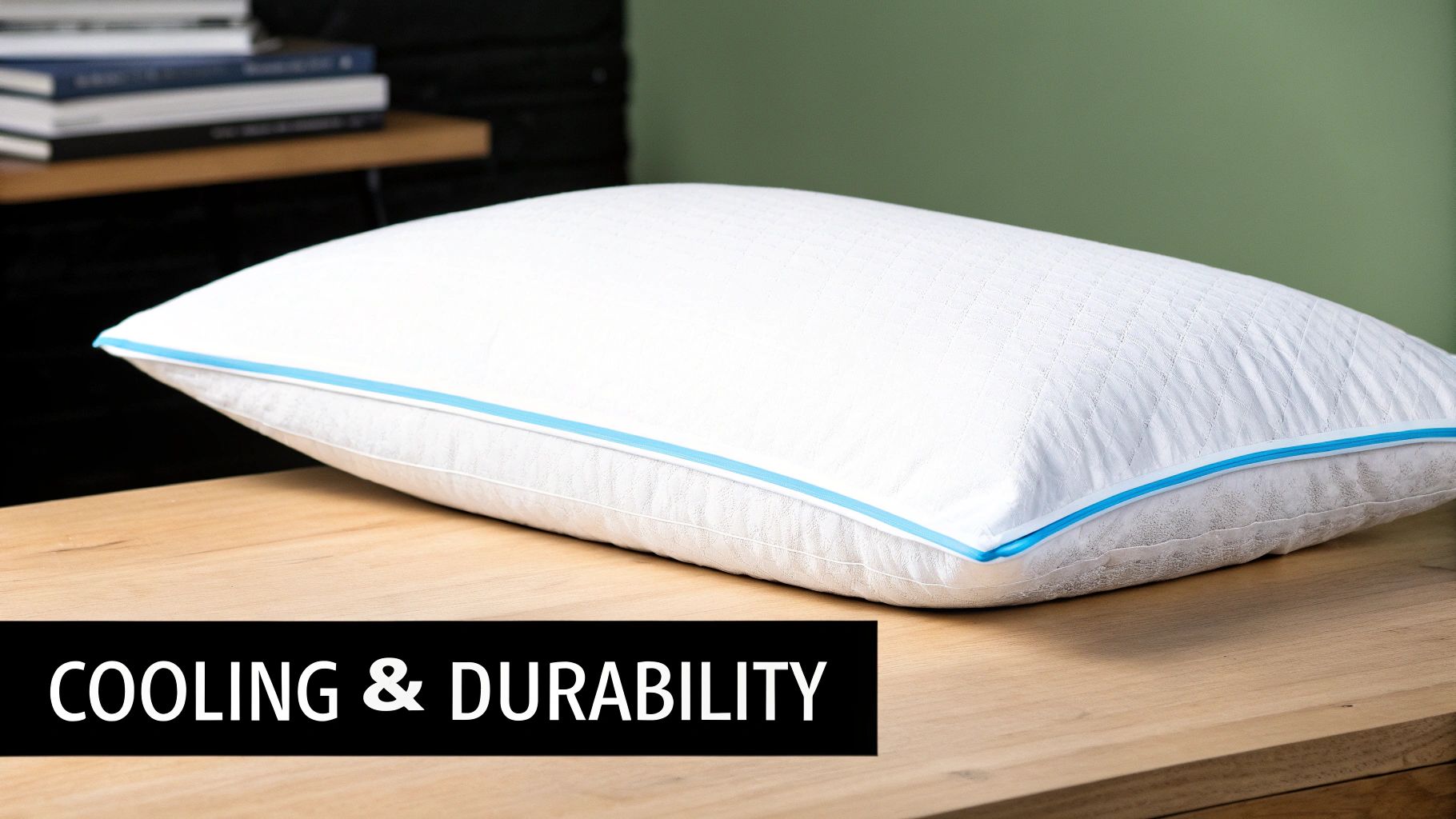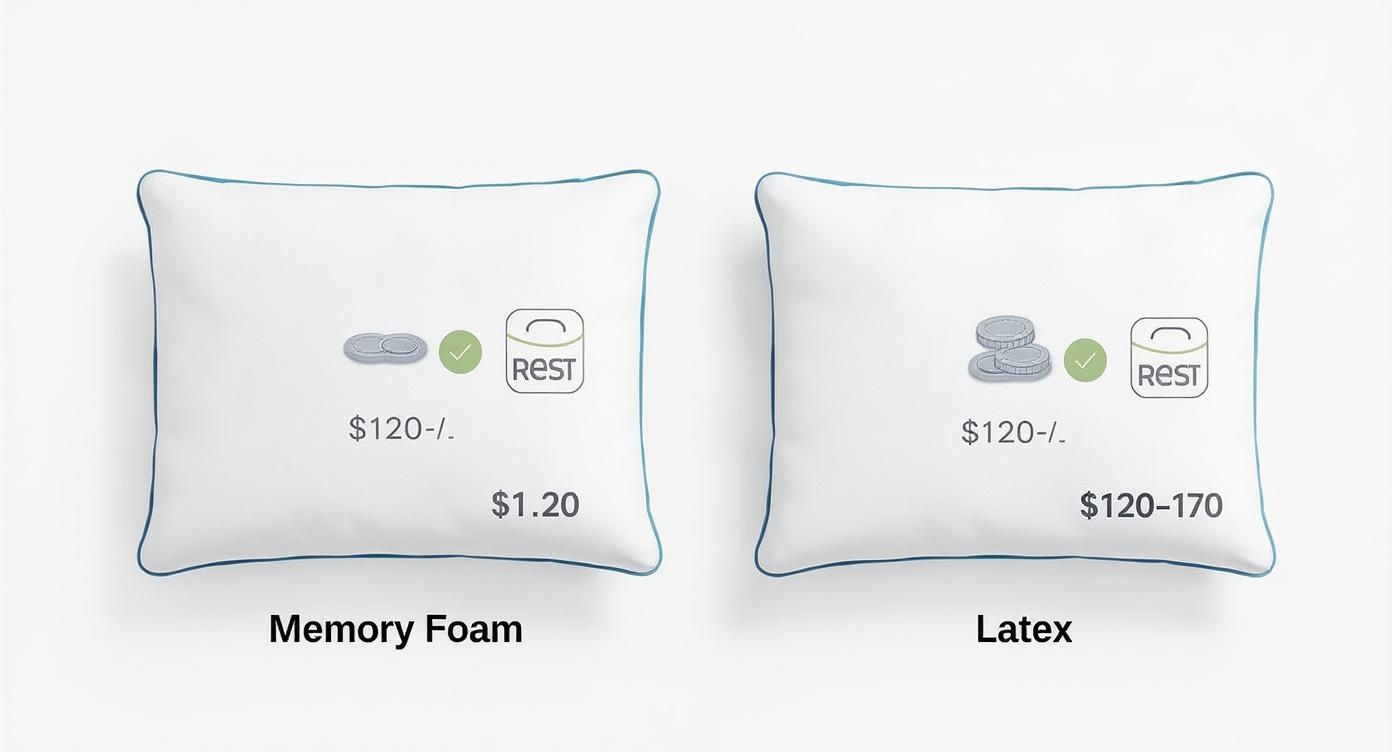Ever wondered why choosing a new pillow feels so complicated? It often boils down to one simple question: do you want a pillow that cradles your head or one that lifts it? Understanding this key difference is the first step in solving the latex vs memory foam pillow puzzle and getting a better night's sleep.
Memory foam offers a slow-sinking, deep contouring feel that moulds perfectly to your shape. In contrast, latex has a buoyant, almost springy feel that supports you without letting you sink in too deeply. Both are fantastic options, but they deliver very different sleep experiences.
Key Differences at a Glance
Picking the right pillow is crucial for your sleep quality, but it's tough to know which is best without trying them. While both offer excellent support, they differ in cooling, responsiveness, and durability.
For example, a side sleeper with shoulder pain might find the precise moulding of memory foam life-changing. But if you're a hot sleeper who tosses and turns, the breathable, bouncy nature of a latex pillow is likely a better fit.
This quick comparison table breaks down the essential details.
| Feature | Memory Foam Pillow | Latex Pillow |
|---|---|---|
| Feel | Slow-sinking and conforming | Bouncy and responsive |
| Support | Cradles head and neck | Lifts head and neck |
| Responsiveness | Slow to regain shape | Instantly bounces back |
| Temperature | Can retain heat (unless gel-infused) | Naturally breathable and cool |
| Durability | 18 months to 3 years | 3 to 4+ years |
| Eco-Friendliness | Synthetic (petroleum-based) | Natural and biodegradable |
While this table gives you a great snapshot, your personal experience will depend on the pillow's quality and your unique sleep needs.
If you're already leaning towards one material, it's worth digging deeper. For instance, you can find great resources detailing the best memory foam pillows and what makes them stand out.

Ultimately, your pillow choice affects everything from spinal alignment to how cool you stay all night. By understanding the unique features of each, you can make an informed decision that truly suits your sleeping style.
What Are They Made Of? Material and Construction
When comparing a latex vs memory foam pillow, the first thing to understand is what they’re made of. Their materials are completely different, which dictates how they feel, support you, and perform overnight.
Memory foam is a synthetic material, also known as viscoelastic polyurethane foam. It was first developed by NASA to cushion aircraft seats. Its main feature is its reaction to heat and pressure—when you rest your head on it, the foam softens and moulds to your unique shape, creating a custom cradle perfect for relieving pressure.
Practical Example: The deep contouring of memory foam is why it's often recommended for people with pressure points. It slowly sinks to distribute weight evenly instead of pushing back.
Latex, on the other hand, usually comes from a natural source: the sap of rubber trees. This makes it a more eco-friendly choice. The process used to create latex foam results in a material that is naturally bouncy, responsive, and breathable.
Two Types of Pillow Perfection
Not all latex is the same. The manufacturing process creates two distinct types, each offering a different feel.
- Dunlop Latex: Liquid latex is poured into a mould in one go. The result is a denser, firmer foam that feels incredibly supportive. It's a great pick for sleepers who need solid support that won’t give way.
- Talalay Latex: This method is more complex, involving vacuum-sealing and flash-freezing the latex before baking. This creates a lighter, airier foam with a softer feel and a bit more "give."
Memory foam also has variations, mainly designed to tackle issues like overheating. While traditional memory foam gives you that classic slow-sinking feel, many modern pillows are infused with cooling gels or have an open-cell structure for better airflow. You'll also find blends, like the popular bamboo memory foam pillow, which combines contouring support with moisture-wicking properties.
Feel and Support: A Side-by-Side Showdown

When it comes to the great latex vs memory foam pillow debate, what truly matters is how each one feels when you lay your head down. Their materials create two completely different sleep experiences.
Memory foam is famous for its signature slow-sinking, deep contouring feel. It uses your body heat and pressure to mould precisely around the curves of your head and neck. Many people describe this as a gentle "hug" that cradles you, which is fantastic for melting away pressure points.
Latex delivers a more responsive and buoyant experience. Instead of a slow sink, your head is gently lifted and supported by a soft yet springy surface. This quick-response feel means the pillow adapts instantly as you shift positions, so you never feel "stuck."
Support Tailored to Your Sleep Style
The type of support each pillow offers is critical for keeping your spine aligned. This is a big deal in Australia’s ergonomic pillow market, which was valued at around USD 16.7 million and continues to grow as people prioritise sleep posture. You can read more about these market trends on cognitivemarketresearch.com.
The deep, cradling support of memory foam is its biggest selling point, excellent at filling the gap between your head, neck, and shoulders.
- For Side Sleepers: The foam contours snugly around the shoulder, helping the neck stay aligned with the spine. If you're a side sleeper, check out our guide to the best pillows for side sleepers for more options.
- For Chronic Pain Sufferers: The personalised moulding distributes weight evenly, which can provide relief for those with persistent neck pain.
Real-World Example: Sarah is a side sleeper who often wakes with a stiff neck. A memory foam pillow would mould to fill the space under her neck, giving her consistent support all night and keeping her spine straight.
Latex provides a more generalised, uplifting support, designed to keep your head elevated and prevent it from sinking too deeply.
- For Combination Sleepers: The natural bounce of latex makes it easy to switch positions without needing to readjust your pillow. It moves with you, offering reliable support.
- For Back Sleepers: A latex pillow offers a stable surface that supports the natural curve of your neck, helping to keep your airways open.
Durability, Cooling, and Health Factors

Beyond the initial feel, a pillow's long-term performance truly shapes your sleep quality. When we compare a latex vs memory foam pillow, three key factors stand out: cooling, durability, and health benefits.
Cooling and Temperature Regulation
A common complaint about traditional memory foam is that it can trap body heat. Because the material uses your warmth to soften and mould, its dense structure can sometimes feel too warm.
Manufacturers have developed clever solutions:
- Gel-Infused Foam: Tiny gel beads are mixed into the foam to absorb and draw heat away from your head.
- Open-Cell Structure: Newer foams are designed with more internal air pockets to improve ventilation and let heat escape.
Natural latex is inherently a cooler material. Its natural open-cell structure makes it breathable right from the start. Air moves freely through the material, preventing heat buildup and keeping the surface comfortable all night.
Durability and Lifespan
A good pillow is an investment, so you want it to last. This is where natural latex truly shines. It is famous for its resilience, and a high-quality latex pillow can easily keep its shape and support for 3 to 4 years or more without sagging.
Memory foam pillows generally have a shorter lifespan, typically lasting 18 months to 3 years. Over time, the foam can break down, losing its ability to spring back. Knowing your pillow's lifespan is key, so it’s useful to understand how often you should change your pillow.
A Real-World Example: Imagine two friends, Alex and Ben. Alex buys a premium natural latex pillow, while Ben gets a standard memory foam one. After two years, Ben’s pillow feels flat and unsupportive. Alex’s latex pillow, however, still feels just as bouncy and comfortable as the day he bought it.
Health and Hypoallergenic Properties
If you have allergies, your pillow's material is a huge deal. Natural latex is a fantastic choice, as it is inherently hypoallergenic and resistant to dust mites, mould, and mildew.
Many memory foam pillows are also made to be hypoallergenic. Since they are synthetic, look for trusted certifications like CertiPUR-US®. This label ensures the pillow is made without harmful chemicals and has low VOC (Volatile Organic Compound) emissions—the source of that "new foam" smell.
Crunching the Numbers: Cost and Value
When weighing up latex versus memory foam pillows, the price tag is often a deciding factor. While there's a price gap at the checkout, the real story is about long-term value.
Generally, natural latex pillows cost more upfront. This is due to the sustainable harvesting of sap from rubber trees and a more involved manufacturing process. However, this higher initial cost often pays off. Natural latex is incredibly resilient, so you won't need a replacement anytime soon.
What's Behind the Price?
Memory foam pillows are available across a wide price range. A basic one can be a bargain, but a high-end model can cost as much as a latex pillow.
Here’s what affects the price of memory foam:
- Density: Denser foam provides better support and lasts longer but costs more.
- Special Features: Cooling gel infusions, open-cell designs, or ergonomic shapes all add to the price.
- Brand Name: A well-known brand often comes with a premium price tag.
Research shows that while the average memory foam pillow in Australia costs around $120, they have a massive 87% customer satisfaction rate. Latex pillows typically range from $120 to $170, reflecting their premium, natural origins. You can dig into these pillow market insights for more detail.
Ultimately, "good value" depends on your needs. An affordable memory foam pillow is great for a tight budget. But investing in a premium latex or top-tier memory foam pillow could mean better comfort and a lower cost-per-night over its lifespan.
So, Which Pillow Is Right for You?
After comparing latex vs memory foam, how do you make the final choice? The best pillow for you depends on your body, your sleeping style, and what you value most.
Choose Memory Foam If...
You are a dedicated side sleeper. The deep contouring is fantastic for cradling your head and filling the space between your neck and shoulder, helping to keep your spine aligned. It's also the go-to if you love that classic "hugging" sensation.
Choose Latex If...
You are a hot sleeper. Its natural open-cell structure promotes airflow, helping you stay cool. It's also a clear winner for combination sleepers who toss and turn, as its bouncy feel makes it easy to switch positions. Finally, if an eco-friendly, long-lasting pillow is a priority, natural latex is hard to beat.
The Bottom Line: Do you prefer the deep, personalised cradle of memory foam or the cool, responsive lift of latex? Answering that question will guide you to a better night’s sleep.
This chart shows the typical price difference you can expect in Australia.
As you can see, latex often comes with a higher price tag, reflecting its natural origins and impressive durability.
Finding the right pillow can transform your sleep quality. If you’re still deciding, it can be helpful to browse a wide selection of pillows to see all the options. For a deeper dive, our complete guide on how to choose the right pillow is packed with more expert tips.
Frequently Asked Questions
Still have a few questions about latex vs memory foam pillows? Let's clear them up so you can choose with confidence.
Do Latex and Memory Foam Pillows Smell?
Yes, both can have a slight scent when new. This is called off-gassing and is temporary. The smell from memory foam is due to its synthetic compounds and usually disappears after a few days of airing out. Natural latex may have a faint, slightly sweet aroma that also fades quickly.
Which Pillow Is Better For Neck Pain?
Both are excellent for neck pain, but they work differently. Memory foam provides deep, personalised contouring that cradles your neck to relieve pressure points. Latex offers a more buoyant, consistent support that lifts your head and neck, keeping everything aligned without the "sinking" feeling.
Actionable Insight: The best choice depends on what feels better for you. Do you prefer a pillow that holds your head in one spot (memory foam), or one that offers responsive support as you move (latex)?
How Should I Clean My Pillow?
Never put a solid latex or memory foam pillow in the washing machine. The intense spinning will tear the foam and ruin its structure. Instead, spot-clean any spills with a damp cloth and a gentle detergent. For a full guide, learn how to wash a pillow the right way here.
Your Best Sleep Starts Now
Choosing the right pillow is a simple but powerful way to improve your sleep and overall well-being. Whether you opt for the cradling comfort of memory foam or the responsive support of latex, you're investing in healthier, more restorative nights.
Ready to discover a new level of comfort? At Sienna Living, we design luxury bedding to transform your sleep. Explore our collection of premium pillows and find your perfect match today.

